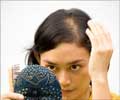- Millions of people experience baldness, and there is no cure as of now
- Scientists have discovered a protein that aids in the growth of long, strong hairs from moles on our skin
- By micro-needling in the scalp, the protein could be used to develop new treatments for baldness
"You don't need to actually invent any new molecules," said hair scientist Maksim Plikus from the University of California, Irvine. "Nature has them all."
Osteopontin: The Fascinating Hair-Grower in your Moles
Plikus and his colleagues discovered osteopontin - a chemical "that has not previously been linked to hair growth" - is extremely active in hairy mole skin in a study published in the journal Nature.Plikus believes that the substance could be needled into the scalps of balding men and women to revive dormant hair follicles in a near-painless Botox -like process.
"The hair people are getting really excited," he said.
But first, this new anti-balding approach, which has already been tested in mice, must be effective in human clinical trials, which are expected to begin this summer.
How Injecting Osteopontin Can be the Next Treatment for Baldness
Plikus stated that he is aware that many individuals are "annoyed" by their hairy moles. Perhaps they'll "pluck it out" or "shave it off."Not him though. He's always been fascinated by how some of our moles send hair stem cells "into overdrive," resulting in long strands of hair in places where hair would normally grow short (1✔ ✔Trusted Source
Signalling by senescent melanocytes hyperactivates hair growth
Go to source).
Plikus believes that injecting osteopontin around aged follicles that have ceased generating hair would stimulate latent stem cells, regrowing bald areas that form on our heads as we age.
"There are these essential signaling molecules that a teenager's hair would be producing in large quantities," he said.
Senescent cells, which are commonly referred to as "zombie cells" due to their negative, inflammatory effects on aging bodies, produce the chemicals in large quantities. Plikus believes that in the case of hair, these senescent cells are performing a crucial and very youthful function: promoting hair to grow in abundance, much like grass on a well-watered lawn.
Don’t Worry Your Head Won’t be a Mole Field
Because osteopontin isn't required for skin pigment to develop and turn into a mole, he's not concerned about treated patients' scalps becoming one huge, bulbous mole field. He stated that any "features of the hair" on a person's head, such as its original color or texture, should be kept because "properties are encoded within the follicle.""It will grow like you remember it when you were 18, it would not grow like thickened, wiry armpit hair," he said. "This burst of molecules is shown to hair follicles on a scalp, and they're like, 'Oh, OK. Time to grow!'"
It’s Complicated: The Relationship Status of How to Get Your Hair Back
Scientists have been searching for a Holy Grail cure for hair loss like this for decades, with little success.There are now just two widely used hair loss treatments that actually work. The medicines are minoxidil and finasteride. Both medications were discovered by chance, neither works perfectly, and neither will work for everyone.
"Hair's complicated," Plikus said.
Scientists are working on a therapeutic agent that can be applied like Botox, through microneedling of hair follicles in the scalp.
Reference:
- Signalling by senescent melanocytes hyperactivates hair growth - (https://pubmed.ncbi.nlm.nih.gov/37344645/)
Source-Medindia
















